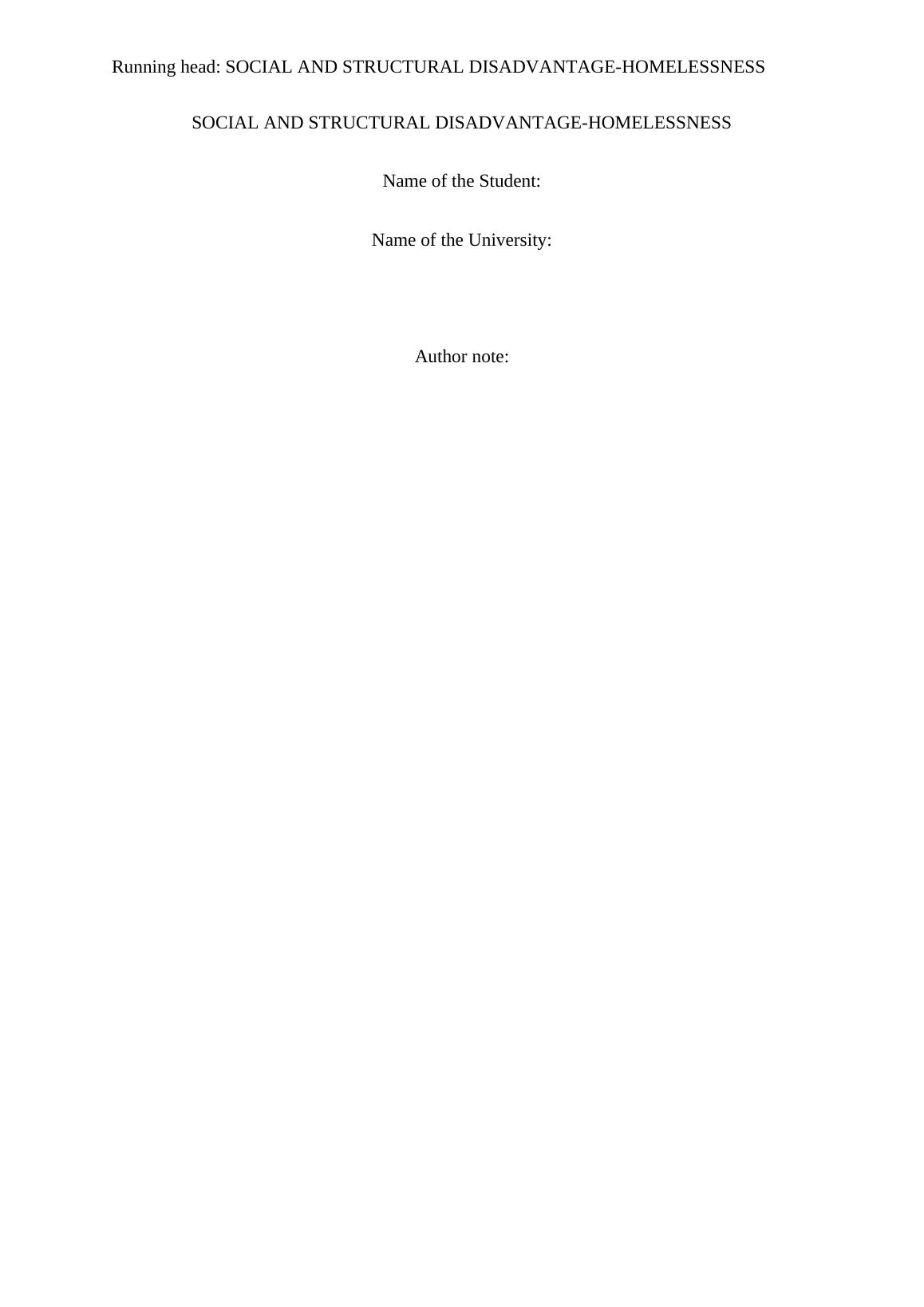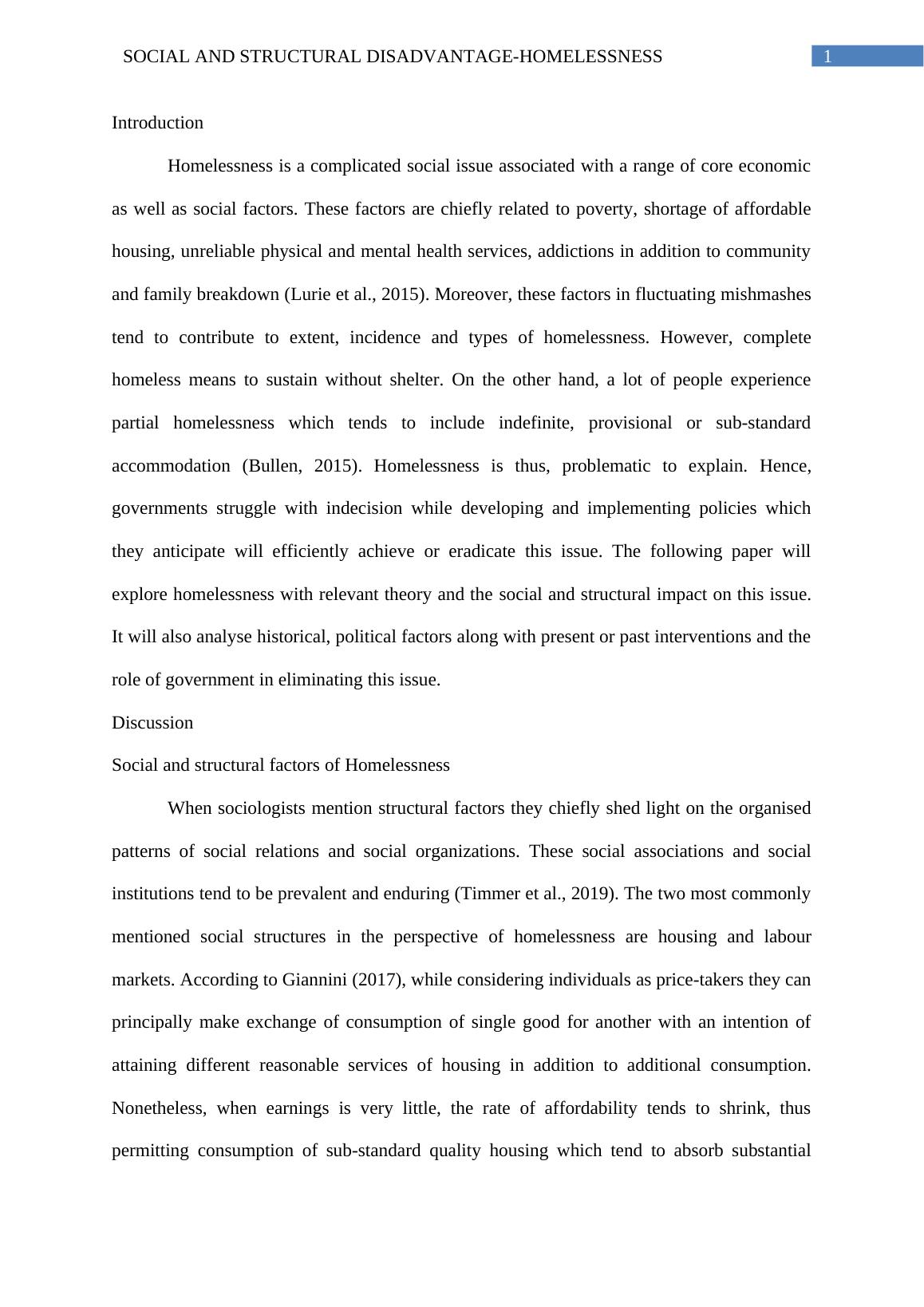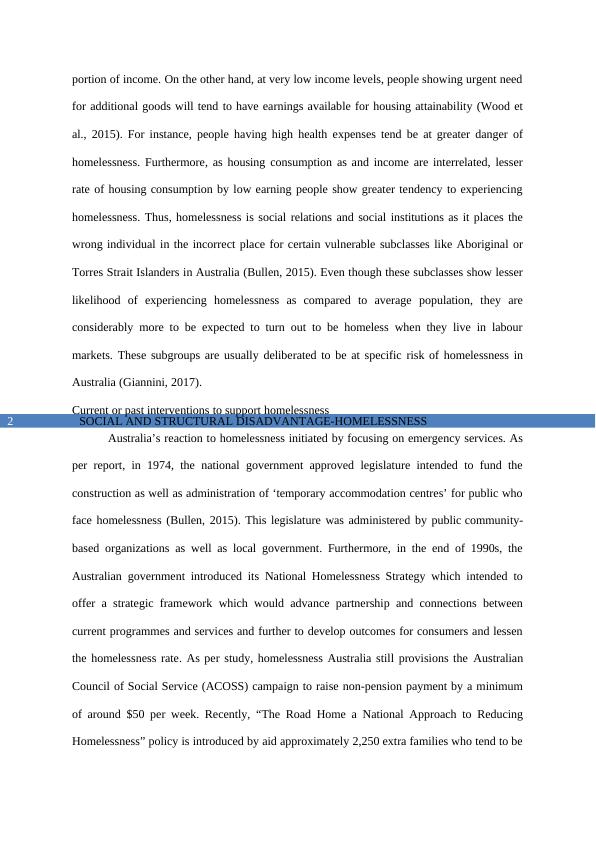Social And Structural Disadvantage of Homelessness
Added on 2022-09-12
9 Pages2181 Words27 Views
Running head: SOCIAL AND STRUCTURAL DISADVANTAGE-HOMELESSNESS
SOCIAL AND STRUCTURAL DISADVANTAGE-HOMELESSNESS
Name of the Student:
Name of the University:
Author note:
SOCIAL AND STRUCTURAL DISADVANTAGE-HOMELESSNESS
Name of the Student:
Name of the University:
Author note:

SOCIAL AND STRUCTURAL DISADVANTAGE-HOMELESSNESS1
Introduction
Homelessness is a complicated social issue associated with a range of core economic
as well as social factors. These factors are chiefly related to poverty, shortage of affordable
housing, unreliable physical and mental health services, addictions in addition to community
and family breakdown (Lurie et al., 2015). Moreover, these factors in fluctuating mishmashes
tend to contribute to extent, incidence and types of homelessness. However, complete
homeless means to sustain without shelter. On the other hand, a lot of people experience
partial homelessness which tends to include indefinite, provisional or sub-standard
accommodation (Bullen, 2015). Homelessness is thus, problematic to explain. Hence,
governments struggle with indecision while developing and implementing policies which
they anticipate will efficiently achieve or eradicate this issue. The following paper will
explore homelessness with relevant theory and the social and structural impact on this issue.
It will also analyse historical, political factors along with present or past interventions and the
role of government in eliminating this issue.
Discussion
Social and structural factors of Homelessness
When sociologists mention structural factors they chiefly shed light on the organised
patterns of social relations and social organizations. These social associations and social
institutions tend to be prevalent and enduring (Timmer et al., 2019). The two most commonly
mentioned social structures in the perspective of homelessness are housing and labour
markets. According to Giannini (2017), while considering individuals as price-takers they can
principally make exchange of consumption of single good for another with an intention of
attaining different reasonable services of housing in addition to additional consumption.
Nonetheless, when earnings is very little, the rate of affordability tends to shrink, thus
permitting consumption of sub-standard quality housing which tend to absorb substantial
Introduction
Homelessness is a complicated social issue associated with a range of core economic
as well as social factors. These factors are chiefly related to poverty, shortage of affordable
housing, unreliable physical and mental health services, addictions in addition to community
and family breakdown (Lurie et al., 2015). Moreover, these factors in fluctuating mishmashes
tend to contribute to extent, incidence and types of homelessness. However, complete
homeless means to sustain without shelter. On the other hand, a lot of people experience
partial homelessness which tends to include indefinite, provisional or sub-standard
accommodation (Bullen, 2015). Homelessness is thus, problematic to explain. Hence,
governments struggle with indecision while developing and implementing policies which
they anticipate will efficiently achieve or eradicate this issue. The following paper will
explore homelessness with relevant theory and the social and structural impact on this issue.
It will also analyse historical, political factors along with present or past interventions and the
role of government in eliminating this issue.
Discussion
Social and structural factors of Homelessness
When sociologists mention structural factors they chiefly shed light on the organised
patterns of social relations and social organizations. These social associations and social
institutions tend to be prevalent and enduring (Timmer et al., 2019). The two most commonly
mentioned social structures in the perspective of homelessness are housing and labour
markets. According to Giannini (2017), while considering individuals as price-takers they can
principally make exchange of consumption of single good for another with an intention of
attaining different reasonable services of housing in addition to additional consumption.
Nonetheless, when earnings is very little, the rate of affordability tends to shrink, thus
permitting consumption of sub-standard quality housing which tend to absorb substantial

SOCIAL AND STRUCTURAL DISADVANTAGE-HOMELESSNESS2
portion of income. On the other hand, at very low income levels, people showing urgent need
for additional goods will tend to have earnings available for housing attainability (Wood et
al., 2015). For instance, people having high health expenses tend be at greater danger of
homelessness. Furthermore, as housing consumption as and income are interrelated, lesser
rate of housing consumption by low earning people show greater tendency to experiencing
homelessness. Thus, homelessness is social relations and social institutions as it places the
wrong individual in the incorrect place for certain vulnerable subclasses like Aboriginal or
Torres Strait Islanders in Australia (Bullen, 2015). Even though these subclasses show lesser
likelihood of experiencing homelessness as compared to average population, they are
considerably more to be expected to turn out to be homeless when they live in labour
markets. These subgroups are usually deliberated to be at specific risk of homelessness in
Australia (Giannini, 2017).
Current or past interventions to support homelessness
Australia’s reaction to homelessness initiated by focusing on emergency services. As
per report, in 1974, the national government approved legislature intended to fund the
construction as well as administration of ‘temporary accommodation centres’ for public who
face homelessness (Bullen, 2015). This legislature was administered by public community-
based organizations as well as local government. Furthermore, in the end of 1990s, the
Australian government introduced its National Homelessness Strategy which intended to
offer a strategic framework which would advance partnership and connections between
current programmes and services and further to develop outcomes for consumers and lessen
the homelessness rate. As per study, homelessness Australia still provisions the Australian
Council of Social Service (ACOSS) campaign to raise non-pension payment by a minimum
of around $50 per week. Recently, “The Road Home a National Approach to Reducing
Homelessness” policy is introduced by aid approximately 2,250 extra families who tend to be
portion of income. On the other hand, at very low income levels, people showing urgent need
for additional goods will tend to have earnings available for housing attainability (Wood et
al., 2015). For instance, people having high health expenses tend be at greater danger of
homelessness. Furthermore, as housing consumption as and income are interrelated, lesser
rate of housing consumption by low earning people show greater tendency to experiencing
homelessness. Thus, homelessness is social relations and social institutions as it places the
wrong individual in the incorrect place for certain vulnerable subclasses like Aboriginal or
Torres Strait Islanders in Australia (Bullen, 2015). Even though these subclasses show lesser
likelihood of experiencing homelessness as compared to average population, they are
considerably more to be expected to turn out to be homeless when they live in labour
markets. These subgroups are usually deliberated to be at specific risk of homelessness in
Australia (Giannini, 2017).
Current or past interventions to support homelessness
Australia’s reaction to homelessness initiated by focusing on emergency services. As
per report, in 1974, the national government approved legislature intended to fund the
construction as well as administration of ‘temporary accommodation centres’ for public who
face homelessness (Bullen, 2015). This legislature was administered by public community-
based organizations as well as local government. Furthermore, in the end of 1990s, the
Australian government introduced its National Homelessness Strategy which intended to
offer a strategic framework which would advance partnership and connections between
current programmes and services and further to develop outcomes for consumers and lessen
the homelessness rate. As per study, homelessness Australia still provisions the Australian
Council of Social Service (ACOSS) campaign to raise non-pension payment by a minimum
of around $50 per week. Recently, “The Road Home a National Approach to Reducing
Homelessness” policy is introduced by aid approximately 2,250 extra families who tend to be

End of preview
Want to access all the pages? Upload your documents or become a member.
Related Documents
Demographic Characteristics and Housing in Logan Citylg...
|8
|1879
|32
Alcohol Consumption and Strategies to Reduce its Use in Australialg...
|11
|2945
|436
